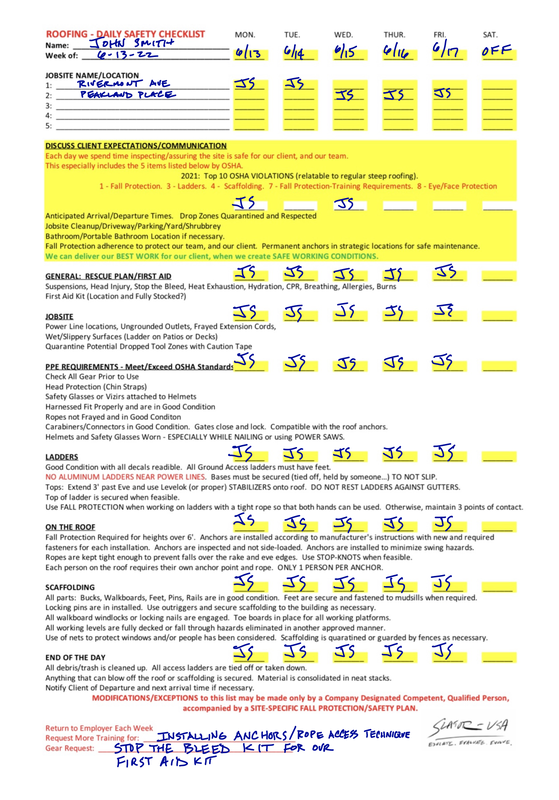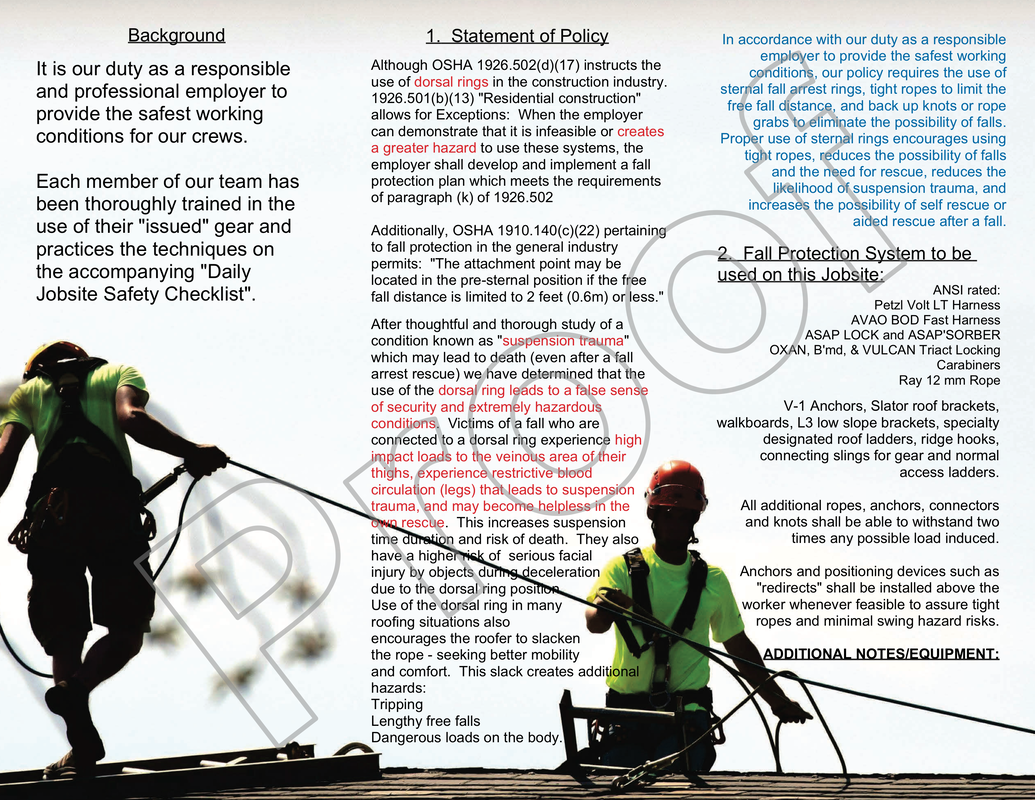Our Mission: Continuously develop and share advanced techniques, systems and gear
to aid people in performing steep pitch roof work safely and simply.
to aid people in performing steep pitch roof work safely and simply.
BENEFITS of UTILIZING a DAILY/WEEKLY SAFETY CHECKLIST:
CLIENT: Reinforces their decision that they hired the best team for their job. Attention to safety detail translates to attention to work detail.
SALESMAN: Clear communication from the Salesman to the Client about what sets your Company apart from the rest: professionalism, safety training, the ability to keep the client's job site safe for everyone who is present while your team works. Each worker on site agrees to creating and maintaining these safe working conditions, and initials daily. Each has the necessary training and gear to perform their work safely. Selling safety begins with the salesman. Clients desire everyone have safe working conditions and are willing to pay for this level of professionalism. Some businesses also charge a Safe Access Set Up Fee. Consider it. It works. It takes time to set up safely. The fee may vary based off the difficulty of the site. Expect more and better referrals.
EMPLOYEES: Completing the checklist helps keep safe working practices present in worker's minds, daily. BEGIN with 15 minutes to complete the checklist, identifying hazards, checking gear, anchors, ladders, potential drop zones, etc ... becoming grounded and focused before rushing into the day's tasks. It helps everyone adhere to the same standards of safety and professionalism daily. It gives each person an opportunity to request training and gear easily, and ultimately helps them go home safely daily. It gives them an opportunity to learn, inspire, and perhaps grow into your next Safety Team Leader Role with more responsibility and pay.
SAFETY MANAGER: This simple checklist helps open a dialogue for Tool Box Talks, training opportunities, gear and technique improvements. It helps reduce hazards, reduce incidents, while building team spirit and safety. It covers the 5 most frequently cited OSHA violations that pertain to most steep roofing sites. Collect these checklist weekly and keep them with your other training records. Use them as creative reward opportunities for lunches, sports tickets, paid time off. Use it to create your own Roofing Safety Level Program that rewards people with raises or bonuses. Ask the employees what will inspire them the most to participate. In 2021, the 7th most frequently cited violation by OSHA was: Lack of Fall Protection Training and Documentation.
BUSINESS OWNER: Benefits of utilizing Daily Safety Checklists for the business owner include: Lower risks. Reduced incidents. Reduced OSHA violations and fines. Lower insurance premiums. Better public image. Better employee retention. More referrals and better clients. Use a "Safe Access Set Up Fee" to fund the gear and training. There is zero downside for creating a culture of safety in your business. Everyone wins.
SALESMAN: Clear communication from the Salesman to the Client about what sets your Company apart from the rest: professionalism, safety training, the ability to keep the client's job site safe for everyone who is present while your team works. Each worker on site agrees to creating and maintaining these safe working conditions, and initials daily. Each has the necessary training and gear to perform their work safely. Selling safety begins with the salesman. Clients desire everyone have safe working conditions and are willing to pay for this level of professionalism. Some businesses also charge a Safe Access Set Up Fee. Consider it. It works. It takes time to set up safely. The fee may vary based off the difficulty of the site. Expect more and better referrals.
EMPLOYEES: Completing the checklist helps keep safe working practices present in worker's minds, daily. BEGIN with 15 minutes to complete the checklist, identifying hazards, checking gear, anchors, ladders, potential drop zones, etc ... becoming grounded and focused before rushing into the day's tasks. It helps everyone adhere to the same standards of safety and professionalism daily. It gives each person an opportunity to request training and gear easily, and ultimately helps them go home safely daily. It gives them an opportunity to learn, inspire, and perhaps grow into your next Safety Team Leader Role with more responsibility and pay.
SAFETY MANAGER: This simple checklist helps open a dialogue for Tool Box Talks, training opportunities, gear and technique improvements. It helps reduce hazards, reduce incidents, while building team spirit and safety. It covers the 5 most frequently cited OSHA violations that pertain to most steep roofing sites. Collect these checklist weekly and keep them with your other training records. Use them as creative reward opportunities for lunches, sports tickets, paid time off. Use it to create your own Roofing Safety Level Program that rewards people with raises or bonuses. Ask the employees what will inspire them the most to participate. In 2021, the 7th most frequently cited violation by OSHA was: Lack of Fall Protection Training and Documentation.
BUSINESS OWNER: Benefits of utilizing Daily Safety Checklists for the business owner include: Lower risks. Reduced incidents. Reduced OSHA violations and fines. Lower insurance premiums. Better public image. Better employee retention. More referrals and better clients. Use a "Safe Access Set Up Fee" to fund the gear and training. There is zero downside for creating a culture of safety in your business. Everyone wins.
SAMPLE CHECKLIST
FOUR PARTS OF A GOOD SAFETY PLAN
Part. 1: A Daily/Weekly Jobsite Safety Checklist which aids crews in reassessing the techniques, gear, and practices utilized on each jobsite. It also helps clearly communicate the need for safety with clients as well as expectations for each day. We have found this to be the most important 15 minutes of each day. SCROLL DOWN TO VIEW OR DOWNLOAD A PDF COPY.
Part 2: A Site Specific Fall Protection Plan to meet OSHA requirements and assure crews are prepared for the day's tasks.
Part 3: Properly trained crews who are dedicated to keeping themselves, their peers, and anyone who visits the jobsite safe. As you develop this crew and continue to provide practical, proper training on a regular basis, work is done safely, morale improves, employee retention improves, unexpected costs go down, and your business gets noticed for the right reasons.
Part 4: A Dedicated Safety Professional and First Aid Trainer. This person, or persons job is to understand OSHA's regulations and look for ways to improve your teams safe working practices as you meet or exceed OSHA's guidelines. Use an independent, local, safety consultant with experience in the roofing field. This provides optimal "checks and balances". Finding and hiring a first aid trainer that will clearly communicate relatable injuries and treatments (without simply using PowerPoint) is the key to having a real learning, recallable experience. Sharing these professionals with colleagues in your region effectively reduces costs while improving their specific knowledge of your current and future needs.
Our clients tell us, almost daily, how happy they are that we take time to work safely. Every business and most job sites are different. You are welcome to modify the templates below for your own needs. It's a simple process to design your own custom brochures online at Vistaprint.com. Contact us if you would like a physical copy and we will gladly send you one.
We hope it helps you, your crew, and your clients!
Ronny Roseveare
Founder
Slator, LLC
Anchor in. Live long.
Part 2: A Site Specific Fall Protection Plan to meet OSHA requirements and assure crews are prepared for the day's tasks.
Part 3: Properly trained crews who are dedicated to keeping themselves, their peers, and anyone who visits the jobsite safe. As you develop this crew and continue to provide practical, proper training on a regular basis, work is done safely, morale improves, employee retention improves, unexpected costs go down, and your business gets noticed for the right reasons.
Part 4: A Dedicated Safety Professional and First Aid Trainer. This person, or persons job is to understand OSHA's regulations and look for ways to improve your teams safe working practices as you meet or exceed OSHA's guidelines. Use an independent, local, safety consultant with experience in the roofing field. This provides optimal "checks and balances". Finding and hiring a first aid trainer that will clearly communicate relatable injuries and treatments (without simply using PowerPoint) is the key to having a real learning, recallable experience. Sharing these professionals with colleagues in your region effectively reduces costs while improving their specific knowledge of your current and future needs.
Our clients tell us, almost daily, how happy they are that we take time to work safely. Every business and most job sites are different. You are welcome to modify the templates below for your own needs. It's a simple process to design your own custom brochures online at Vistaprint.com. Contact us if you would like a physical copy and we will gladly send you one.
We hope it helps you, your crew, and your clients!
Ronny Roseveare
Founder
Slator, LLC
Anchor in. Live long.
PART 1: DAILY JOBSITE SAFETY CHECKLIST - ROOFING
PART 2: SITE SPECIFIC FALL PROTECTION PLAN
- As required by OSHA 1926.501(b)(13) for exceptions.
- As required by OSHA 1926.501(b)(13) for exceptions.




